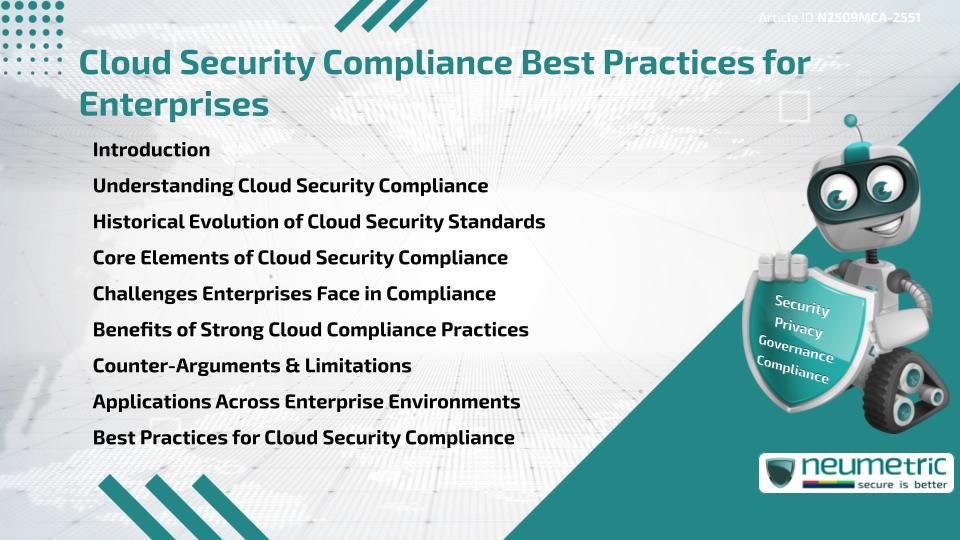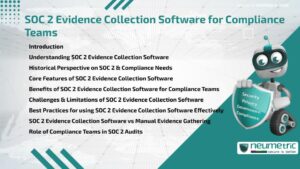Table of Contents
ToggleIntroduction
Cloud Security Compliance is critical for enterprises that rely on Cloud computing to store, process & manage data. It involves following Legal, Regulatory & Industry Standards that safeguard information in Cloud environments. With growing Cyber Threats & strict Data Protection laws, enterprises must adopt Compliance frameworks to ensure Customer Trust, prevent Breaches & avoid Penalties. Without strong Compliance, Organisations face Risks of data loss, reputational harm & regulatory consequences. This article explores what Cloud Security Compliance is, its history, core components, challenges, benefits, limitations & Best Practices for enterprises.
Understanding Cloud Security Compliance
Cloud Security Compliance refers to the set of Policies, Procedures & Technical safeguards that ensure Cloud systems operate securely & align with applicable regulations. It covers areas such as Data Privacy, Access Control, Monitoring & Encryption. Just as building codes ensure safe construction, Compliance frameworks make sure Cloud systems are built & operated securely. Enterprises that embrace Compliance can innovate in the Cloud while maintaining Accountability.
Historical Evolution of Cloud Security Standards
Security frameworks predate Cloud adoption, with standards like ISO 27001 & NIST Cybersecurity Framework guiding early digital safety. As Cloud technology matured, new frameworks emerged to address its unique Risks. Regulations such as GDPR, HIPAA & SOC 2 were adapted to Cloud environments, making Compliance mandatory for many industries. High-profile breaches involving Cloud misconfigurations emphasised the need for dedicated Cloud Security Compliance. Lessons from these incidents shaped today’s emphasis on Continuous Monitoring & shared responsibility models between Cloud Providers & Enterprises.
Core Elements of Cloud Security Compliance
Enterprises must address several key elements when adopting Compliance:
- Data Governance: Ensuring proper Data Handling & Privacy Controls.
- Identity & Access Management: Implementing strong Authentication & Least-privilege principles.
- Encryption: Protecting data at rest & in transit.
- Continuous Monitoring: Tracking activity to detect anomalies.
- Audit & Reporting: Maintaining documentation for Accountability & Verification.
Together, these elements function like the pillars of a secure fortress, making Compliance frameworks resilient against Cyber Threats.
Challenges Enterprises Face in Compliance
Enterprises encounter several hurdles when implementing Cloud Security Compliance. These include navigating complex regulatory landscapes across multiple Jurisdictions, managing Vendor relationships under shared responsibility & addressing misconfigurations caused by human error. Cost is another challenge, as Continuous Monitoring & Audits demand resources. Smaller enterprises may also struggle with expertise, while larger Organisations deal with Compliance at scale across hybrid & multi-Cloud environments.
Benefits of Strong Cloud Compliance Practices
Adhering to Compliance provides significant advantages. It safeguards Sensitive Data, reduces liability Risks & enhances Customer Trust. For industries like Healthcare & Finance, Compliance ensures adherence to mandatory laws. It also helps enterprises build stronger cyber resilience, reducing the impact of potential attacks. Just as regular maintenance extends the life of machinery, ongoing Compliance practices extend the security & reliability of Cloud systems.
Counter-Arguments & Limitations
Critics argue that Compliance Requirements can slow down innovation & create administrative burdens. They also highlight that Compliance alone does not guarantee absolute security, as new Threats may bypass existing frameworks. While these concerns are valid, non-compliance carries far greater Risks, including legal penalties & brand damage. The goal is to integrate Compliance seamlessly into enterprise workflows, ensuring that it supports rather than hinders innovation.
Applications Across Enterprise Environments
Cloud Security Compliance plays a role across industries. In Healthcare, it ensures patient Confidentiality under HIPAA. In Finance, it supports fraud prevention & protects Customer Data under PCI DSS. Technology companies adopt Compliance to safeguard Intellectual Property, while Government agencies use it to secure sensitive operations. These applications show that Compliance is both a Regulatory requirement & a Business enabler.
Best Practices for Cloud Security Compliance
Enterprises can strengthen their Compliance efforts by following these Best Practices:
- Conducting regular Risk Assessments & Audits.
- Training Employees on Cloud Security Awareness.
- Aligning with Global Standards like ISO 27001, NIST & GDPR.
- Implementing automated Compliance tools for monitoring.
- Establishing clear Vendor Management practices.
- Embedding Security by design in all Cloud deployments.
By adopting these measures, enterprises can achieve secure, compliant & trustworthy Cloud operations.
Conclusion
Cloud Security Compliance is a cornerstone of modern enterprise operations. It ensures Organisations meet Regulatory requirements, protect Sensitive Data & build Trust with Stakeholders. While challenges exist, the benefits of robust Compliance far outweigh the costs, making it essential for secure enterprise Cloud adoption.
Takeaways
- Cloud Security Compliance protects enterprises against Risks & Penalties.
- Core elements include Governance, Identity Management, Encryption & Monitoring.
- Challenges include cost, complexity & Vendor responsibility.
- Compliance enhances Trust, Resilience & Regulatory alignment.
- Best Practices embed Compliance into enterprise workflows for lasting security.
FAQ
What is Cloud Security Compliance?
It is the set of Policies & standards that ensure Cloud systems operate securely while meeting regulatory & industry requirements.
Why is Cloud Security Compliance important?
It protects Sensitive Data, prevents Breaches, builds Customer Trust & avoids Legal penalties.
What industries require Cloud Security Compliance?
Industries such as Healthcare, Finance, Government & technology rely heavily on Compliance due to Sensitive Data handling.
What are the main challenges of Compliance?
Challenges include regulatory complexity, cost, Vendor responsibility & Risk of misconfigurations.
Is Compliance enough to guarantee Cloud Security?
No, Compliance reduces Risks but does not eliminate them; enterprises must combine Compliance with strong security practices.
How can enterprises achieve Cloud Security Compliance efficiently?
By aligning with Global Standards, using automated Compliance tools & training Employees on secure practices.
What role does the shared responsibility model play in Compliance?
It defines which security responsibilities lie with the Cloud provider & which remain with the enterprise.
Need help for Security, Privacy, Governance & VAPT?
Neumetric provides organisations the necessary help to achieve their Cybersecurity, Compliance, Governance, Privacy, Certifications & Pentesting needs.
Organisations & Businesses, specifically those which provide SaaS & AI Solutions in the Fintech, BFSI & other regulated sectors, usually need a Cybersecurity Partner for meeting & maintaining the ongoing Security & Privacy needs & requirements of their Enterprise Clients & Privacy conscious Customers.
SOC 2, ISO 27001, ISO 42001, NIST, HIPAA, HECVAT, EU GDPR are some of the Frameworks that are served by Fusion – a SaaS, multimodular, multitenant, centralised, automated, Cybersecurity & Compliance Management system.
Neumetric also provides Expert Services for technical security which covers VAPT for Web Applications, APIs, iOS & Android Mobile Apps, Security Testing for AWS & other Cloud Environments & Cloud Infrastructure & other similar scopes.
Reach out to us by Email or filling out the Contact Form…





